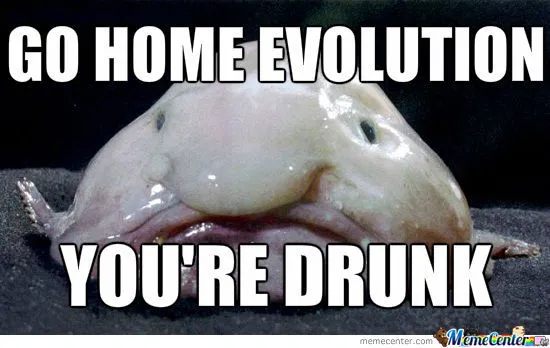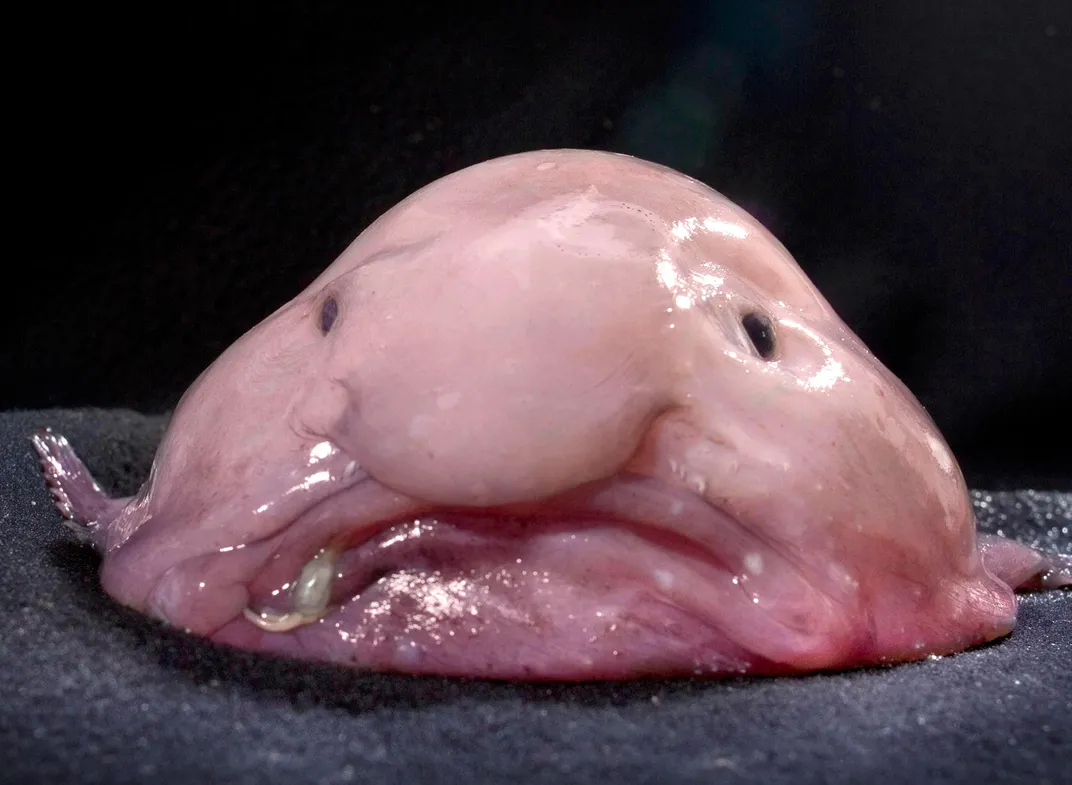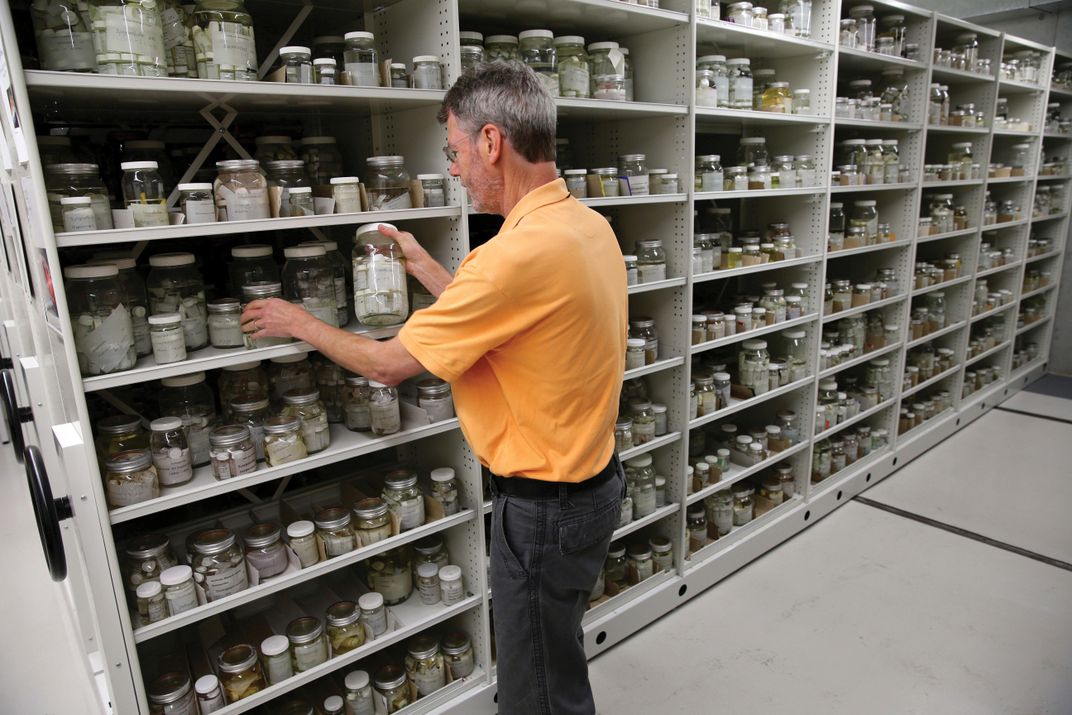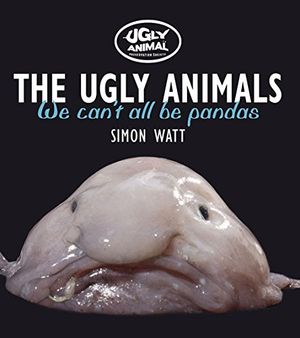Behold the Blobfish
How a creature from the deep taught the world a lesson about the importance of being ugly
:focal(2140x940:2141x941)/https://tf-cmsv2-smithsonianmag-media.s3.amazonaws.com/filer/b4/de/b4decdf7-4f59-4966-8033-b09d1250543a/nov2015_a01_blobbycol.jpg)
The world’s most misunderstood fish reposes in pickled splendor on a shelf of the basement archives at the Australian Museum’s Ichthyology Collection, in Sydney. The smeary flesh of Mr. Blobby—as the photogenic blobfish is affectionately known—is no longer Bubblicious-pink. The famous downturned grin is gone, the tiny currant eyes have receded in deep alcoves, and the nose—which once evoked Ziggy of comic strip fame—is shaped less like a turnip than a fallen soufflé.
Dredged up off the coast of New Zealand during a 2003 research voyage, the specimen has spent the last decade suspended in a 70 percent ethyl-alcohol solution. “The fixation process tightened Mr. Blobby’s skin and collapsed his—or her—snout,” laments Mark McGrouther, the museum’s fish manager. “He—or she—now looks like an 85-year-old Mr. Blobby.” Indeed, these days the Blobster suggests nothing so much as a freshly Botoxed baked potato. Has there ever been crueler proof that alcohol changes the way you look?
Of the hundreds of deep-sea critters hauled in on the New Zealand expedition, the Psychrolutes microporos was the breakout star. A photograph snapped aboard ship lit up on social media and transformed this squidgy bottom feeder into an aquatic Grumpy Cat, with devoted followers on Facebook, Instagram, Twitter and Tumblr.
Seen by few but known by many, Mr. Blobby has been deemed huggable enough for plush toys and has inspired an ocean of silly poems, apps, emoji, smartphone games with tag lines like “Build Up Your Hero and EVOLVE! What Strange and Wonderful Things Will He Become?”, memes (“Go Home Evolution: You’re Drunk”) and even a song by children’s book author Michael Hearst:
Michael Hearst - Blobfish | Listen for free at bop.fmBlobfish, blobfish, JELL-O of the sea—
Floats upon the bottom, lazy as can be...

**********
Two years ago the blobfish was voted the earth’s most hideous species in an online poll conducted by the British-based Ugly Animal Preservation Society. In its quest to raise awareness of Mother Nature’s endangered but “aesthetically challenged children,” the UAPS chose 11 nominees and enlisted an equal number of comedians to film short videos on their behalf. Paul Foot, the comic who championed the blobfish’s candidacy, maintained, “The sad face of the blobfish belies a kind and very wise little brain in there.”
So Mr. Blobby is a bit of a self-promoter. OK, a world-class self-promoter. In an “interview” on a museum-themed website, the blobfish boasts about predicting the winners of the FIFA World Cup and the Australian Master Chef competition, and reporting live from the red carpet of the Eureka Prizes—the country’s most prestigious science awards event. In a very real sense, the Creature From Deep-Down Under has demonstrated how museums can publicize their physical objects in a digital world.
Aussies embrace their blobs. This is the country that’s home to the so-called pitch drop viscosity experiment, the longest-running—and most tedious—lab test of all time. In 1927, a University of Queensland physics professor placed a blob of congealed tar pitch in a funnel to see how fast it would flow. Eighty-eight years later, nine drops have fallen. To date, more than 31,000 “watchers” have logged into the live webcam that monitors the drips. Despite very little happening, the feed is still more compelling than most shows on Australian TV.
That is, unless the show features Mr. Blobby. A recent episode of “The Octonauts”—a kids’ cartoon program about the underwater adventures of Captain Barnacles and crew—involved Bob Blobfish and his brothers, Bob and Bob. The painfully still Blobfish Bros don’t so much bob in the ocean as hover over its floor.
As often happens with celebrities, the story of the Beast From 650 Fathoms has taken on a life of its own. If tittle-tattle is to be believed, Mr. Blobby was separated at birth from either Kilroy, Mr. Magoo, the pudding-faced comedian Louis CK or Donatella Versace, the fashion designer with lips so plump she can whisper in her own ear.
The most persistent gossip is that blobfish suffer a significant threat and possible annihilation. “I’m not quite sure why that is,” Foot said in his campaign pitch. “Could be because mankind is destroying its habitat, or maybe bad people have been stabbing the blobfish, or it could just be that the blobfish has been a bit careless.”
In Northern Ireland, the Belfast Telegraph ran a story about the plight of endangered blobfish, which it claimed often die as bycatch in fishing trawlers. In England, a Guardian editorial carped about “anthropomorphic lookism” and its distorted priorities: “The blobfish has something better than the regular features and soft contours of conventional beauty: with its droopy mouth and gelatinous cheeks, it has an appealing vulnerability. Unfortunately, not enough to tug at the heartstrings of deep-sea trawlermen fishing off the Australian coast, for whom it’s just collateral damage.”
As it turns out, the truth lies elsewhere—in this case, the dark depths at 3,900 feet below the surface of the Tasman Sea.
“Hardly has a muscle, but doesn’t seem to mind.
It eats what floats into its mouth— crustaceans and some brine.”
**********
Mr. Blobby was discovered during a joint Australian-New Zealand exploration of submarine habitats around Norfolk and Lord Howe islands. A team consisting of two dozen scientists spent four weeks on the RV Tangaroa sampling the fauna along the islands’ two long underwater mountain ranges.
The ship towed trawling gear along the ocean floor, netting more than 100 new species of fish and invertebrates. Among the catch were corals, sea cucumbers, gulper eels, fangtooths, coffinfish, prickly dogfish, viperfish, slickheads, giant sea spiders and the fossilized tooth of an extinct megalodon—a shark many times the size of the great white. There were spookfish (part squid, part fountain pen), whose snouts were equipped with electrical receptors to detect hidden prey; sponges as tall as ten feet; and humpback anglerfish—also known as black devils—that use bacteria to emit light through the long stalks sprouting from their heads.
One day while surveying the Tangaroa’s recently departed, expedition photographer and marine ecologist Kerryn Parkinson came upon what Mark McGrouther describes as a “very soft, very goopy fish, about the length of a comic book. While the ship swayed, the jiggly mass slid to and fro, even in death.” Drooping from its lower lip—like the unlit cigarette that forever dangled from Humphrey Bogart’s—was a parasitic copepod. A blob within a blob.

Parkinson took a picture. “He looked so human!” she recalls. “He had that certain charisma that demands attention.”
The name Mr. Blobby derived not from the menacing slimeball in the 1958 horror film, but, according to some, the bulbous, pink and yellow polka-dotted bumbler—Britain’s answer to Barney—who once topped the Independent’s list of 10 most irritating television characters. “Personally, I doubt that explanation,” protests McGrouther. “I think it’s called Blobby because, out of the water, it’s a limp, flabby thing that can’t support its own weight. So it splodges.”
Blobfish belong to the fathead sculpin family, the piscine equivalent of the Addams Family. (Creepy and kooky, mysterious and spooky.) This “altogether ooky” animal is found in the Pacific, Atlantic and Indian oceans at depths between 330 and 9,200 feet. Unlike most fish, they have no swim bladder to help maintain buoyancy. “If Mr. Blobby had an air sac, he would collapse under the extreme pressure,” McGrouther says. “Instead, he uses water as a structural support.” The blobfish’s blancmange of a body is less dense than water, allowing it to drift passively above the seabed. Having realized long ago that activity does them no good, they tend to remain almost, if not entirely, still.
Like other lie-and-wait predators, blobfish stick around until anything remotely edible floats into their open jaws, then suck it in. Though food may be scarce in the deep and trawlers sometimes cast wide nets, McGrouther thinks it’s a stretch to say blobfish have been pushed to the brink: “The Tasman Sea is very big and deep-sea trawlers very few.” In an emphatic redundancy, he will add this: “Mr. Blobby is certainly dead.”
McGrouther reckons Mr. Blobby succumbed while surfacing, a victim of the dramatic change in water temperature. “His mashed facial features may have resulted from being stuck at the back of the net, squeezed between all sorts of other marine life. By the time he was dumped on the deck of the Tangaroa and exposed to the air, his skin had relaxed. He would have looked a good deal less blobby on the seafloor.”
Though the precise life expectancy of blobfish is unknown, deepwater fish generally tend to live longer than their shallow-water counterparts. Some stay alive for more than 100 years because of their lack of predators, and slow rate of growth and reproduction. How do blobfish mate? “Nobody knows,” McGrouther says. “I’d guess they lock in a clinging, rather conjugal embrace.”
Is a blobfish edible? “I’ve never spoken to anyone who’s tried to eat one. I suppose Mr. Blobby would taste like chicken. On the other hand, chicken may taste like Mr. Blobby.”
Considering that McGrouther decided not to dissect the Australian Museum’s most celebrated specimen, how can he be sure it isn’t Ms. Blobby? “It’s possible,” he says. “I could properly sex and ID him, but I like the fact that he’s the one-and-only Mr. Blobby.”

Mr. B got entangled in social media the same way he got snagged in a research net: by accident. In 2010, the blobfish was showcased on “The Gruen Transfer,” a popular Australian TV show about the advertising industry. In a segment that judged the best creative treatment for hard-sells, two agencies were challenged to fashion campaigns around “saving the blobfish.” Which is how the extinction rumor got started.
A Sydney firm gave Mr. Blobby a Photoshop makeover. Its opponent, from Brisbane, dispatched a chubby middle-aged man to the streets. Nude except for swim trunks and a strap-on nose only Pinocchio might covet, he blobbed through city squares, restaurants and bus stops brandishing two signs. One read: “How Would You Like It If I Trawled Your Bottom?”; the other promised, “50,000 Signatures and I Go Back to Where I Belong.”
Within a week, Mr. Blobby had 500 Facebook followers.
The blobfish’s cyber-profile got an even bigger boost in 2013 when it won the ugliest animal competition and became the preservation society’s official mascot. Among the other contestants were a jumping slug, the world’s only parrot that can’t fly (the kakapo), a salamander that never grows up (the axolotl) and the Andean “scrotum” water frog. Residents of Lima make a frappe of this alleged aphrodisiac by skinning it and running it through a blender. Alas, few members of the UAPS electorate would vote for, much less touch, pubic lice, whose existence reportedly has been put at risk by bikini waxing.
McGrouther thinks the honor is undeserved. “That was a sacrilege, really unfair,” he says. “I used to have an ugly dog named Florence, a mongrelly-looking thing. She was blind and had lost most of her hair and her mind, though never her appetite. Mr. Blobby is far more attractive than Florence.”
So attractive that a few years back the museum exhibited the blobfish in its own display case. Schoolchildren were encouraged to leave mash notes. The most memorable: “You remind me of my teacher.”
McGrouther says Mr. Blobby is part of the museum’s permanent collection. “He’s not terribly at risk here,” the curator says. “We haven’t had bomb threats and no terrorist has demanded that we hand over Mr. Blobby. He’s quite comfortable in his little watery grave.”
...And yes it has a saddened look; perhaps it’s feeling down—
For, thanks to fishing trawlers
Soon this fish won’t be around.
The Ugly Animal Preservation Society asks why handsome, zoo display-worthy animals get the lion’s share of publicity, research, protective legislation, and public and private financial support. “People have always shouted ‘Save the Whale,’” says biologist Simon Watt, the organization’s president, “but until now no one has stood up for gob-faced squid or the hundreds of species that go extinct every day.”
Watt says humans tend to be partial to mammals and “narcissistic” in their attachment to nature. “We only care about animals that remind us of ourselves, or those we consider adorable,” says Watt, author of The Ugly Animals: We Can’t All Be Pandas. “We prefer big eyes, bushy tails and animals that have, at the very least, recognizable faces.”
He argues that though tigers and snow leopards hog all the attention in the fight to preserve species, the ugly ducklings—dull, unloved, neglected—play an equally important role in the ecological web. Consider the naked mole rat, which is nearly as repulsive as the blobfish. “Science has shown that the rats are pain resistant and unable to get cancer,” Watt says. “As a result of this find, cancer research for humans has edged forward, and the mole rat no longer looks quite so ugly.”
Told (gently) that that blobfish isn’t endangered after all, Watt lets out an audible sigh. “I’m pleased but sad,” says the evolutionary biologist. “Pleased because anything not endangered makes me happy, but sad because maybe the award should have gone to an animal like the Tonkin snub-nosed monkey, which is in dire straits and could use the press. But if the blobfish’s victory has made people aware that extinction is a wider problem, that’s all for the good.”
To the baby boomers, a generation once young and idealistic and which felt largely unappreciated, the baby harp seal and its huge pleading eyes symbolized a certain level of ecological awareness. With the aging of those innocents, the blobfish—inert, indolent, in a state of perpetual maritime melancholy—may be the new face of our relationship with nature, the planet, the future.
Mr. Blobby is a fish for a world gone soft in the head.

The Ugly Animals: We Can't All Be Pandas